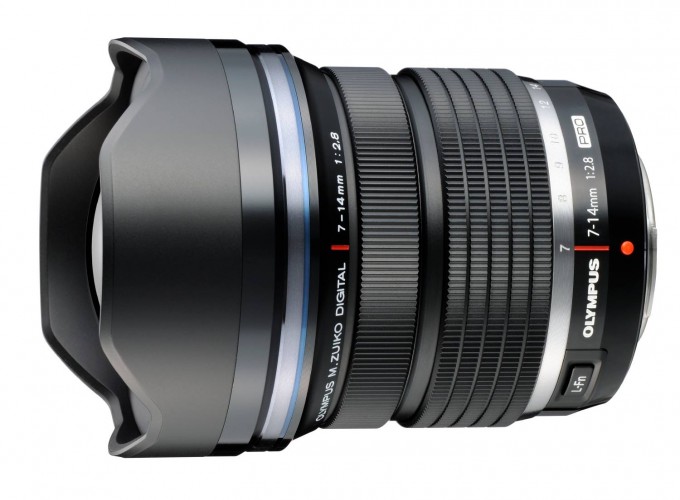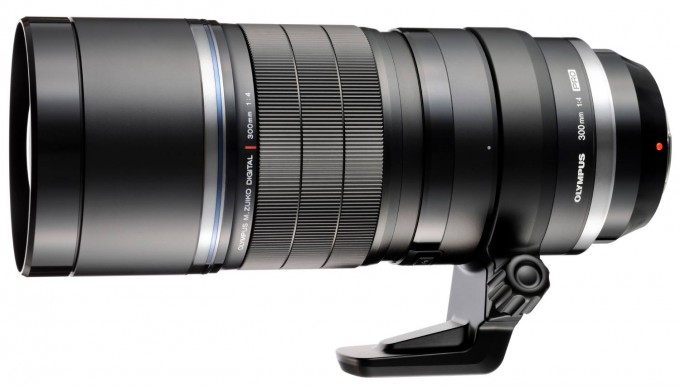New Olympus 7-14 2.8 PRO and 300 f/4 PRO Announced!
It seems that at least every week or two we hear of something new in the camera world. The funny thing is I only report on a small percent of it! I talk about those products that are interesting to me and the readers here and there is still an endless stream of products to report on.
Olympus is once again paving the way and providing those who invested in the amazing E-M1 with a couple of rewards 🙂 TWO new pro lenses. The 7-14 Wide Angle F/2.8 Zoom and the 300mm f/4 prime (600mm equivalent). These are both PRO lenses and will be dust and weatherproof with all of the good stuff that normally comes along with these great Olympus lenses (Image quality, pristine build and feel..oh and probably a big price tag).
Olympus promised new pro glass, and they seem to be delivering. These new lenses are expected to ship in 2015 so we have a while to go but at least we know what is on the way! The new 12-40 is already out and gaining rave reviews (my review is coming soon) so with these two lenses one would have a nice pro 3 lens kit. 7-14, 12-40 and 300 offering a 14-28, 24-80 and 600mm equivalent. There is also the 40-150 2.8 PRO scheduled to be released THIS year giving an 80-300 Equivalent.
Oly knows how to make fantastic lenses. Now I wonder what they have in store for us in 2015 in regards to a new pro body? Will they have an E-M1 successor already or will they wait a while?
From Olympus…
“The first interchangeable lens of this series, the M.ZUIKO DIGITAL ED 12-40mm 1:2.8 PRO is already available while its successor, the M.ZUIKO DIGITAL ED 40-150mm 1:2.8 PRO, is scheduled to go on sale in the second half of 2014. The final two Olympus system lenses in the M.ZUIKO PRO quartet, covering everything from super wide angle to super telephoto, are currently under development. Both new lenses are scheduled to be released from 2015 onwards. More details will be announced prior to the launch.”





Great news, but I realy miss a super fast 17mmPro (F1.2 or 1.4) …. 😉 why did Oly only produce zoom Pro lenses?
Why does Olympus produce zoom pro lenses? Hmmm. There is a 17 0.95 for Micro 4/3 and it is one of the best lenses available for the system. Best build, amazing IQ, Leica like in use…same goes for the 25 0.95 and 42 0.95. You can approach Leica quality with these lenses and they are a cinch to use and focus on the E-M1. AF lenses of this caliber would be humongous. The Zooms are f/2.8 to keep the size down and the only thing that makes them more pro than say the 25 1.8 or 75 1.8 is that they are weather sealed. IQ is no better. The 17 1.8, 25 1.8, 45 1.8 and 75 1.8 are all “pro” quality in my book. The Voigtlander 0.95’s take it up a notch from there.
Of course Steve, you are right, but there is NO weather & dust sealed fast fix lense. Normaly I only prefere to shoot with 35mm equiv. Therefore I would have a fast weather & dust sealed 17mm.
The 60mm prime is weather sealed, but perhaps you did not include it because
F2.8 is not fast enough. In any case it in a different focal length range than the 17mm you want.
Huff: Please comment on this. I know you are a huge M1 fan. My own opinion, from all reviews I’ve read, is that it’s a great camera. I love the idea of 5-axis IS, and am SO disappointed in Sony along these lines. However (don’t shoot me) but in my opinion, the M1 is a fairly large camera (by today’s new compact standards), about the size of FF Sony. So…do you think Olympus will create a new M1 that houses an APS-C sensor, and still have all the existing capability of the M1? Would the existing 4/3 lenses work on it? If Sony can put FF in same-size body, why can’t Olympus at least put an APS-C in the M1? Call it the MC.
Why? Why why why would Olympus abandon the format that is doing so well for them, a system tuned to a vast percentage of the buying market and a system that they have invested a massive amount in just to have a slightly different sized sensor? It makes no sense whatsoever.
If they wanted to explore the alleged advantages of using larger sensors and accept the many compromises (in terms of system size, weight, cost and usability), why stop at APS-C? Or 35mm. Why not do what Leica did with the S system? No point in compromising…
I think guys at Olympus are very well on the track when it comes to the camera size. You can get the one of the PEN cameras if you want to go small&light (perfect with slower zooms or those tiny fixed focal lenses). If you want built-in EVF you have now 3 cameras to choose from M1, M5 and M10. The M1 is aimed at (semi?)pro market – one expect those users often to grab some of the pro zoom lenses (like the new 12-40/2.8) and there you do not want to have tiny and light body where you have hard time to hit the correct button. Also the body-lens weight balance is important imo. If the dynamic range and color depth will further improve – there will be less and less reason for many potential users to go with larger format (of course unless you need 30+ Mpix or better DOF control).
1) A 4/3 sensor isn’t *that* much smaller than an APS-C sensor, and especially not a Canon APS-C sensor. Despite the oft-quoted 17.3mm x 13mm size, the physical chip itself is 18mm x 13.5mm. I highly suspect APS-C sensor sizes are quoted in physical chip size, and not imaging area. The difference of a couple of mm here and there is geometrically enlarged when multiplying in two dimensions.
2) A 4/3 sensor is smaller than APS-C in the dimension that counts the most in order to reduce lens size: the width. The height difference between Canon APS-C and 4/3 is 1.3mm. A DSLR 3:2 format wastes more of an image circle because of its rectangular configuration. 4:3 ratio (also the same ratio as a medium format 6×4.5 sensor) is more square, and better utilises the image circle projected by a lens. That’s why Sony APS-C lenses for the NEX cameras are so big. 3:2 is great for landscape shots, but rubbish for the vertical orientation, where you would normally crop it to get an 8×10 print. Do that, and the APS-C size advantage is almost eliminated.
3) If you *really* want to go down the rabbit hole that is DXO, the latest crop of 4/3 sensors is “better” than any Canon APS-C, past or present.
4) There is a lot more to a high-quality photo than just a bloody sensor. The most important, obviously, is person behind the camera.
5) If Olympus were to ditch 4/3 to make APS-C or to offer it in parallel, that would mean redoing all of their lenses for very little concrete image quality benefit. That’s a one-way ticket to bustville.
Great stuff! While we are waiting for that Pro quality wide zoom Steve, how about reviewing the 9mm body cap lens? Looks like a lot of fun!
I just purchased one and while I’m sure it has it’s uses it just did not do anything for me. It turned my lovely E-M1 into a cheap point and shoot. And I like to have a real lens bolted to the body rather than using a cap. So even at the low price I’d rather save the dollars for a real lens. But that’s just me. Can’t wait for the pro wide zoom. Might have to get the 9-18 to tide me over till 2015.
I wonder how much the 300mm F4 will cost. I’d consider getting into micro 4/3 if it’s not to expensive.
Yep. Finally. Pre-ordered already the 300mm F4. All what’s left now is a EC14 converter.
Should also be fun with the GH4 and 4K.
B
Adding the 300mm to GH4 will be sports action/wild life videographers’ power package.
I shoot a 14mm (Canon FD, full frame, film) regularly for close focused wide angle shots. To do these i need to focus hyperfocally. They ‘re sharp from about 10 cm from the front of the lens to infinity. I thought I’d get the Sony A7 for that lens, but I’m so happy with my Olympus PEN that I ‘d rather buy this 7-14mm.
What I really regret is that there ‘s no distance scale. I could live with having no DOF scale, but close focus wide angle shots are very difficult in composition as the image changes radically and unexpectedly tilting the camera. With this 7-14mm I’d have to autofocus at something at hyperfocal distance and then compose while holding the shutter half depressed all the time. If I lose the push one moment I’ll have to refocus and start over again composing.
I don’t know yet if this is workable. I’d so much like Olympus to get a distance scale on their lenses.
Dirk.
Don’t be so sure there is no distance scale. It is probably there but, like the 12-40, you would have to pull back the focus ring to see it. I think that is highly likely.
If it’s like the 12-40 F2.8, you’ll be able to pull back on the focus ring to expose a distance scale and put the lens into manual focus. The 12-40 does this (and some of the others in their premium series) and it even automatically turns on peaking on the È-M1.
I’m looking forward to this lens. Now give me a Zuiko 9mm F1.8 Tilt/Shift and I’ll be really happy.
Olly will take over the action / sports DSLR camera market from Canikon. Much lighter, just as fast, and image size more that adequate for the sports pages.
I won’t argue your point, but I think that Oly needs to add full phase detect AF with tracking that competes with D4 and 1DX before they start winning converts on the sidelines. But if they do, watch out.
As someone that used to shoot sports professionally (with Olympus gear no less) and who owns a couple m4/3 bodies (alongside a d3s), they’re nowhere near what you can do with full frame mirrored cameras at this point. And they have a mountain of perception to overcome. Not going to happen any time soon.
I’ll probably get the 7-14/2.8 to go with my E-M1 & 12-40/2.8, but not sure about the 300/4 … but I am glad it’s being announced.
I just love the E-M1 and the M43 system in general. I still have a D800E but I rarely have a desire to pick it up any more. The thing I most love about the E-M1 and the system is that it’s like have a couple of systems in one. Some days I’m happy to shoot with the 12-40/2.8 with the JB Grip Base attached (got that tip here) and then at other times I’ll just have one of the smaller primes attached … the camera then takes on a totally new complexion and is like a little Cooper S 🙂
With the risk of being feathered here: mft might well be a dead end wherefore I`d never buy such expensive lenses for it.
I wouldn’t buy them due to size and the fact that I an not a big lens (as in BIG lens) or zoom guy..but I can state that the doom of M 4/3 has been going on for years now and it is only gaining steam and getting stringer by the year. It’s not going anywhere. I would predict the death of Fuji before Micro 4/3.
Yeah, I have tried all them, Fuji, FF and m4/3’s and I think the aps-c sensor is the one that may lose out. To me the whole point of having something other than FF is size and after looking at the lens sizes for Fuji, you might as well plan on going to sony’s FF. I know the lens selection isn’t there yet but I think it’s the future (along with tradition FF dlsr’s since the ecosystem of lenses is already out there.)
I maintain a very small FF kit for low light and that extra IQ but the m4/3’s cameras and lenses work for me 95% of the time. Honestly though if you shoot the big zoom lenses the Sony doesn’t make sense either.
m4/3 is a much bigger risk than Fuji. Anyone banking on Oly or Panasonic over Fuji should stay out of the stock market.
Pannie especially and M43 generally are beloved by videographers.
M43’s not going anywhere.
The industry is in an interesting place right now. I used to hold the opinion that APS-C — and full-frame’s move to compact mirrorless cameras — would push M4/3 out of the industry. I’ve since come to a different opinion. Here’s why:
– M4/3 is rapidly closing the IQ gap with APS-C, while offering a much lighter and more compact system overall. If improvements to sensor IQ continue (and they almost assuredly will), then more IQ quality may be necessary for all but the most extreme of situations (e.g. poster-sized or massive fine-art enlargements). We’re already getting better acuity and color accuracy from M4/3 than we ever got from the best 35mm cameras … and slightly better enlargement capability, too.
– The compact, mirrorless full-frame camera will never be more than a niche product, IMO. It’s an engineering accomplishment more than a useful photographic tool. Fine for short focal length fixed primes and moderate slow zooms, but outside this range, fast optics have to be DSLR-sized due to the inherent nature of the sensor. Boom, there goes the size/weight/balance equation right there. Unless Sony figures out how to engineer small, fast, autofocus full-frame lenses, I see little hope for this trend gathering much momentum…
– APS-C will continue to flourish, I think. Those sensors are getting better as well, they are used by more manufacturers in more cameras than any other serious format right now, and offer a good compromise of quality, size, and weight, when you look at systems like Fuji’s X line.
I agree with you. However, there is still one variable, which is Canikon. If they both offer a mirror less FF allowing to use all their lenses a compact FF might not be an engineering accomplishment alone, as it gives the possibility to stay compact. However, if your emphasis is on the word “compact” I agree. For me small is nice, but there is a minimum size I am comfortable with. Even the EM1 is almost too small for me for longer shooting sessions. A DSLR grip is more comfortable to hold imo. But thats personal preference.
I’m still amazed looking at my files (comparing EM1 and D610) how good m43 for 90% of my shooting really is.
The Nikon AF-S 300mm f/4 sells for about $1369 … less than the Nikon AF-S 14-24 f/2.8, so I actually think the Zuiko 7-14mm f/2.8 will be around $1200-$1300, while the Zuiko 300mm f/4 will probably come in around $1000 – $1200.
I don’t know how I could ever afford that 300mm but it could be the first time ever I was in a system not wanting for any lens (especially if they produce a matching 1.4 teleconverter). If the 12-40/f2.8 is around ⅓ the price of the 14-35/f2, what chance the 300/f4 would be ⅓ the price of the 300/2.8? I’m so happy with Olympus right now I could kiss them!
Olympus did post a patent for a new 1.4 TC at the same time as the 40-150mm patent. So we may see it announced later this year with the 40-150mm.
http://translate.google.ca/translate?hl=en&sl=ja&u=http://egami.blog.so-net.ne.jp/2013-11-25&prev=/search%3Fq%3Dhttp://egami.blog.so-net.ne.jp/2013-11-25%26newwindow%3D1
I think it will easily be half the price of the 300mm f2.8. If you look at other makers they are around $1300-1400 US. Micro 4/3s has a higher pixel density on the sensors so the lenses need to be made to a bit higher level. I’d expect it runs a few hundred more than other brands and less than $2000. Size and weight will be comparable to other 300mm f4 lenses.77mm filter size.
I like wide, so the 7-14 is if high interest.
wow. It is really good to see all these new MFT lens being released. Now the range of lens available for MFT that was already very good, will be even better!
7-14 looks awesome!
I can’t believe we will have to wait for 2015 for the ultra-wide. I was hoping that to be my next lens :-/
Fantastic news, never had any regrets since moving to m4/3rds. At least this gives enough time to see which body parts can still be sold.
I have been using 4/3rds cameras since pretty soon after the E-1 first appeared, and since this was bought with the 14-54mm lens, when the 7-14mm appeared, I bagged one of the very early ones of these and never regretted the cost, size and weight of this optic. I don’t know if I’d replace it with the f2.8 version, unless it turns out to be optically, significantly better.